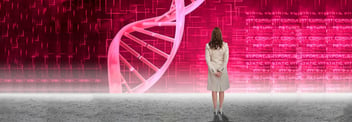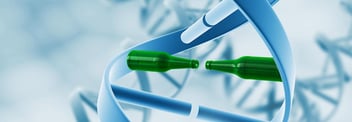DNA: I Am Who I Am… or Am I? – Session Three
- Home
- Blog

A Simple Cheek Swab Brings Good Karma
“Your genetics is not your destiny.”
– George M Church
“DNA + Environment + Triggers + Chance = the Structure and Function of All of the Cells in Your Body. A simple cheek swab can transform your destiny and bring Good Karma into your life and the lives of those you care about.”
– Bruce Alan Kehr, M.D.
Reader, do you believe in Karma? This spiritual principle is defined different ways in different cultures, but the core meaning of the word is preserved in all its interpretations: Simply put, our actions have consequences. Our actions can, in fact, change outcomes, reshape our lives, our futures, our very destiny. Karma implies context: It suggests that no outcome can be entirely removed from its circumstances. And karma can give us hope: it grants us an agency in our everyday lives by suggesting that our fate is in our own hands—that we can slowly, steadily shift our place in life towards something better, and more whole. So why, as a psychiatrist, am I dipping into spiritual belief systems? I don’t mean to sound grandiose, but when it comes to our fates, our futures, and our belief systems, it’s crucial to pinpoint where our own viewpoints fall. It’s only once we believe in our own power to change our lives that we can truly begin shaping our destinies. I like the concept of karma because of the way it puts us at the front and center of our fates. And, surprisingly, it aligns with one of the most revolutionary ideas to come out of psychiatry in the last century: the biopsychosocial model. As a “Healing Companion,” I believe in doing whatever it takes to help my patients, and giving you as many tools as possible to take charge of your life, and the lives of those you care about. And the biopsychosocial model is what allows you and me to see all of the tools available to help people feel better and take charge of their destinies. So this week, as we continue to mull the answers to the question: Is DNA Destiny? I want to show you exactly how this model alerts us to our own power to alter our futures, and outlines the way our actions have real consequences. It’s the scientific side of karma—and learning its basic principles will provide you the power to change your life.
Introduced by the physician George Engel in 1977, the biopsychosocial model upended decades, if not centuries, of medical practice by suggesting our human systems cannot be explained merely on a biological basis alone. Instead, Engel argued, medical practitioners must take into account not just a patient’s biological mechanisms, but also psychological and social factors unique to them. His famous example involved a man who had a heart attack. From a physiological perspective, the heart attack could be directly attributed to a blood clot (and nowadays, to a genetic variant we can test for that predisposes one to a heart attack if we don’t address it proactively with epigenetic modifiers—more on that in a later blog). But how much freedom and agency do we have over our own bodies if a clot or a gene alone are what cause our heart to “attack us?” Not much. The biopsychosocial model, however, suggests we take a look at what caused the physiological mechanisms, from the psychological—did this patient suffer from stress or anxiety, both of which have serious biological impacts?—to the social—was the patient surrounded by a competent team of doctors who he could communicate with? Was his stress caused by a social setting that could’ve been avoided? By adding a psychological and social perspective to biological matters, we give both context and the tools for empowerment. You may not be able to control every illness your body may sustain, but you can absolutely control the circumstances that may increase the odds that you will develop a certain disease. You can lessen the probability through epigenetic influencers, as you will come to learn from me in the weeks and months ahead.
But here’s the catch: Things have undoubtedly changed since the seventies, and while the biopsychosocial model remains crucial to my practice, we’ve learned something equally revolutionary in the last decade: That those very tools given to us by the model are not intangible. In fact, the “psycho” and the “social” leave measurable marks on how our very genetic code expresses itself. In other words, we now know that DNA expression—how it codes for the very proteins that determine the structure and function of our cells—is not just something that occurs in the labs—it’s something that we have the power to change in our own bodies, every day. It’s something we can control. And by doing so, we are participating in the revolutionary field of Actionable Genomics.
The biopsychosocial model and actionable genomics is so infused in my own practice and medical philosophy that the concept formed the backbone of my last two blogs in this DNA series. In my introductory blog, I discussed how psychosocial causes—like learned helplessness and social defeat stress—can impact your genetic code. In my second blog, we took a deep dive into the field of epigenetics, discussing further how our environment can switch on or off genes that have the power to change our moods, our thinking, even our drives. Together, our biological, psychological, and social circumstances define who we are—but the more we understand how our actions can work to strengthen, or worsen, what is written into our genetics right now, the more we can determine our destiny.
Actionable Genomics is karma for the scientific field: it suggests that what we get out of our DNA—and therefore our very futures—depends on what we put in. For the next few weeks, we are going to describe two revolutionary genetic tests to you, based in a simple cheek swab, and then go through your genes one by one to determine how you might influence them for the better. Stay tuned—your destiny is within your power to control!
DNA: I Am Who I Am… or Am I? Blog Series
- Does DNA Determine My Destiny?
- Tinker with Your Genes to Determine Your Destiny
- A Simple Cheek Swab Brings Good Karma
- Test Your DNA to Determine Your Reality
- The BDNF Gene: Use “Fertilizer” to Grow a Majestic ”Rainforest Brain”… and Introducing “GENiE” and “DNA 4 KIDS”
- The MTHFR Gene: “Manufacture” Your Way to Health and Happiness Featuring “DNA 4 KIDS” with “GENiE”
- The SLC6A4 Gene (Serotonin Reuptake Gene): Improve Your Mood and Anxiety through a Simple Cheek Swab Featuring “DNA 4 KIDS” with “GENiE”
- Tame that Emotional Roller Coaster Ride Genetic Testing for the ANK3 Gene and CACNA1C Gene Featuring “DNA 4 KIDS” with “GENiE”
- Is Addiction Inherited? Genetic Testing for the OPRM1 Gene, Opioid Abuse, and Alcoholism Featuring “DNA 4 TEENS” With “GENiE”
- Surf’s Up: Use Your Genetic Code to Ride the Stress Wave with Ease The COMT Gene Featuring “DNA 4 KIDS” With “GENiE”
- Mental Illness is not a Myth—and Human Genomics Proves It The DRD2 Gene and Dopamine Featuring “DNA 4 KIDS” With “GENiE”
- ADHD in the Age of Distraction The Tricky Genetics behind ADHD and ADRA2A Featuring “DNA 4 KIDS” With “GENiE”
- Overweight and Obesity – Is it Me, or My DNA? 5HT2C and MC4R: Can Your Genes Make You Fat?
- Is Alcoholism Inherited? Can a Tiny Gene Help Treat It? The GRIK1 Gene
- 2018 Women’s Health and Wellness Summit DNA Keynote Address
Related Information
- Learn about Genetic Testing
- Learn about Potomac Psychiatry
- Meet Our Doctors
- Contact Potomac Psychiatry


